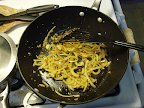Background
Burma (Myanmar) is a large country, around the size of Texas, with 125 ethnic groups. It lies between China and India in southeast Asia. Given the repressive nature of the current military government, I expected finding information on the country to be difficult. I was disappointed. A quick internet search gave lots of results and Wikipedia page on Burmese cuisine was very complete and detailed. While looking for books I quickly found lots of resources.
The three books that were the most useful for both culture and recipes were The Burmese Kitchen, Best of Burmese Cooking, and Cook and Entertain the Burmese Way. Finding what defines traditional Burmese food is rather difficult given that it lies on trade routes between the major culture of India, China, and Thailand. All of these cultures influence Burmese cuisine in some way. Traditional Burmese cuisine is concisely defined as the food in Burma that has not been influenced by it neighbors.
I found three major breakfast dishes. The first is mohinga, which is a fish and noodle soup served by street vendors. Ohhnokaukswe is a chicken and coconut noodle soup in a curry. Kaungnyin paung is traditional farmers dish made of glutinous rice with black eyed peas. Nanpyar is a commonly eaten flat bread, which while mentioned in all of the books it never appear with a recipe except in one book which has it in correctly listed in its index. I chose the mohinga because I like catfish and because it is considered the national dish, but mostly because I like catfish.
Before starting this recipe please be advised that this makes a lot. The recipe below is supposed to give 6 servings but I would estimate it at least 10 portions.
Soup Concentrate
- 2 lbs of catfish
- 2 stalks of lemongrass
- 1 inch fresh ginger
- ¼ tsp tumeric
- 1 tsp shrimp paste
- 1½ tbsp fish sauce
- 4 dried red chilies
- 5 cups of water

- Break open the ginger to expose the inside.
- Cut the lemongrass into smaller pieces to fit in the pot.
- Cut you your catfish fillets in half.
- Put all the ingredients into a pot, bring to a boil, and simmer for 30 minutes.
- Remove the fish from the broth and strain out the solids while retaining the broth.
- Remove any bones from the fish if necessary.
- While the broth is simmering, prepare the rest of the ingredients below.
Complete Soup
- ½ cup jasmine rice toasted in a dry skillet, then ground to a powder in a food processor
- 2 tbsp roasted peanuts, ground (use nut grinder if available)
- 1½ tbsp semolina
- 8 oz chickpeas, cooked
- 2 tbsp peanut oil
- ¼ tsp tumeric
- 1 onion, thinly sliced
- 2 garlic cloves, finely chopped
- ¼ inch fresh ginger
- ½ tsp paprika
- ½ tbsp salt
- 1½ tbsp fish sauce
- ½ tbsp sugar
- 6 peeled shallots (these are substitutes for banana stems)
- 8 oz of somen noodles
- Mix powdered rice, semolina, and peanuts in 1 cup of water. Let it stand for at least 15 minutes.
- Mix chickpeas and 1 cup of water in a food processor.
- Heat the oil in a pot large enough to contain the final quantity of soup.
- Add onions, garlic, ginger, turmeric, and paprika to the oil and cook for two minutes at medium high heat.
- Add the fish and cook for another 5 minutes. Stir regularly.
- Stir in salt, sugar, and fish sauce.
- Add rice/semolina mix and chickpea paste.
- Bring to a boil, add shallots, and simmer uncovered at low heat for an hour. Stir regularly.
- Once the soup has thickened, cook the somen noodles and add them to the bottom of a bowl, then cover with soup.
- Season to taste with lime juice and garnish with scallions.
This breakfast look a long time to make. Fortunately we had a dinner of wings and pizza the night before so we were not super hungry. The length of the simmering and the broth making resulted in very deep flavors and this probably better simulated what it would be like to get this from a street vendors who has had their pot going all day. The flavors are very full and as the fish dissolves it gives the soup a porridge-like texture. The lime juice provides a very nice bite. I really gobbled this down. This would be great on cold mornings.
We also used fresh lemongrass in this recipe. When we previously used lemongrass for the Indonesia breakfast we used the dry product and the taste was awful. Using the fresh lemongrass makes a complete difference.
I feel very certain that an equally acceptable version of this could be made in a much shorter time. The initial broth could be made the night before or you could make the paste and thicken it while you are making the broth. Adding less water would also get the job done. Also invite friend over when you make this, because you make a lot!



No comments:
Post a Comment